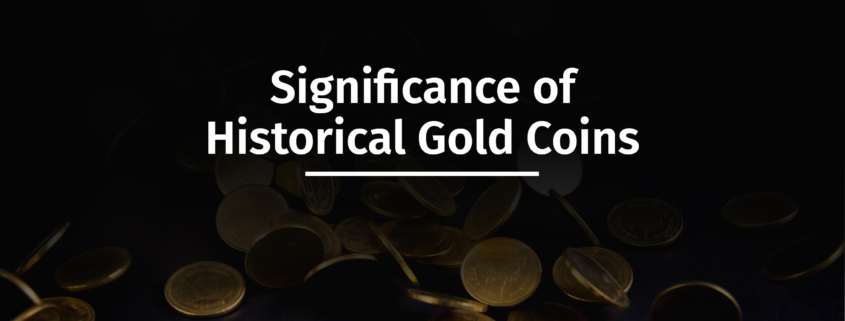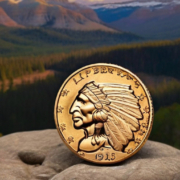Historical Gold Coins: From St-Gaudens to Pre-33 Indian and Liberty Eagles
Everything that shines is not gold! Because gold is valuable. So valuable that it has been used as circulation coins, that is currency in monetary economics, for the most part of civilizational history.
Historical gold coins before the 1933 Executive Order 6102 by the 32nd president of the United States, Franklin Delano Roosevelt, are still revered as commemorative coins for collectors or bullion coins for investors.
Owing to the cultural gold coin values, especially in the South Asian and East Asian markets, the gold spot price, meaning the current gold price being sold on the day and time of the transaction determined per ounce and quality, keeps fluctuating.
Although individuals can’t buy gold at a spot price, only near its spot price, this volatility led gold coins to be taken out of currency circulation by most modern economic nations worldwide, through a wide array and series of strong confiscation legislations.
The Significance of Historical Gold Coins
Despite being pulled out of circulation, historical gold coins continue to captivate collectors and investors alike and capture the attention of the analysts of these markets, remaining a significant player in the precious metals industry. Here’s why:
Numismatic Value – Numismatics is the study or collection of currency, including coins, tokens, paper money, medals and related objects, among the broader discipline of the study of money and other means of payment used to resolve debts and exchange goods. Historical gold coins out of circulation are numismatic coins, in the sense that they are rare in supply, high in demand or valuable because they possess an external value above and beyond the base value of the precious metal, sometimes added by their historical significance. The 1907 $20 St-Gaudens gold coin, High Relief Double Eagle, produced by the Philadelphia Mint, for instance, can be worth 500 times the gold spot price. According to the Numismatic Guaranty Corporation (NGC), which classifies coins as Mint State with a numerical grade between 60-70, gold coin values with a grade of 62 can be around $25,500, $62,500 with a grade of 65, $180,000 with a grade of 67, and $685,000 with a grade of 69 today.
Diversification – In the modern world of investment, you do not need to be a big capital owner to be an investor. Wealth generation and accumulation, especially for the long-term, is becoming more and more accessible to the growing middle-class. With thousands of approaches made available by financial institutions and fund managers alike, you too can now build and maintain an investment portfolio by allaying risks and expecting greater returns. Diversification sits at the center of this method. Instead of putting all your eggs in one basket, you can choose how to allocate your financial resources in an array of investment options – be it stocks, mutual funds, commodities and precious metals, bonds, non-fungible tokens (NFTs), blockchain and cryptocurrencies, real estate, startups and small businesses, cash instruments, exchange-traded funds (ETFs), and so on and so forth! Within precious metals, for example, you can further diversify your portfolio, as can you with any other investment options mentioned, by choosing to buy gold, silver, platinum, palladium, etc.
Exemption from Confiscation – Historical gold coins today are noted for their rarity, high demand, intricate designs, historical significance, investment potential and collectible value. But perhaps what make them irresistible is their potential exemption from confiscation, the likes of which happened in 1933 by an executive order, one of its kinds, by the 32nd president of the United States, Franklin Delano Roosevelt. This required Americans to turn in all bullion gold, with an exemption for “gold coins having recognized special value to collectors of rare coin.” Though gold confiscations have historically been used as an antidote for capital flight or bank runs that occur during economic turmoil and are deemed extremely useful by political and economic functionalists as adequate measures to battle times of crises, collectible gold coins can still be legally bought today at reasonable premiums over bullion prices and therefore have been exempted from confiscation.
Limited Supply – It is obvious that historical gold coins, as the name implies are a part of history itself, is going to be limited in supply, is it not? What does that mean? Simply put, for the collectors and investors markets they are in high demand! Rare gold coins like the pre-33 US gold coins issued by the Philadelphia, Denver, New Orleans, and San Francisco Mints like the $5 or $10 Indian Eagles or Liberty Eagles, or the pre-1933 St-Gaudens gold coins featuring Saint-Gaudens iconic Liberty design and the image of the American bald eagle in flight, are extremely rare to find in Mint State condition. This generates an insane demand for these coins among numismatic enthusiasts, thereby driving their prices up like anything!
When bought from reputable distributors their grading can be checked by third parties like Professional Coin Grading Service, a division of Collectors Universe, Inc., an American company focused on the authentication of coins with an estimated market value of over $36 billion.
Historical Significance – Finally, to understand this point it would be better to widen our search for the history of gold coins to the history of gold itself. As per goldfundamentals.org, in 560 BC the Greek begin mining gold in the Mediterranean. Then, the Romans established large-scale gold mining operations, where it was a symbol of imperial wealth, power, and ambition. Owing to its universal acceptance, gold coins were used as a standard form of currency, with the first known gold coins being around 700 BC. Its material value transcended its appeal being used for adornment and as a medium for artistic expression until then. With international (Chinese, Greek, Roman) adoption of gold coins as a medium of exchange, gold coins of the same weight had the same value everywhere, rendering any need of fixed exchange rates as unnecessary. Finally, after the Age of Exploration, with the introduction of the gold standard, wherein the value of a country’s currency has a direct and fixed relation to gold, it became a linchpin of global economies during the 19th and early 20th centuries.
Also Read: American Eagle Gold Coin: Symbol of Prestige & Investment





